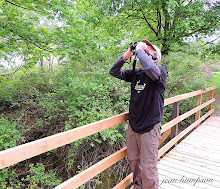Counting down from 100 to 1, the birds listed in '100 Birds to See Before You Die' are from all parts of the globe, living in a variety of habitats. The book has surely increased my desire to travel, as forewarned by Kenn Kaufman in the book's foreword.
The book has a species checklist listed in the back. Oh, no! I now have another list in which to add observed birds. Well the list is immediately decreased by 3. Only 97 to go!
The three birds ticked are all North American species, the most recent being the Snowy Owl (#47 on the book's list) on December 15 of last year. Jean and I assisted with the St. Catharines CBC and at the round up we were informed of the observation of the owl. So the following day we travelled a rural road in west St. Catharines to successfully witness LIFER #252 sitting at the edge of a ploughed field.
We have to go back to 2007 for the second bird, #99 on the book's list. On April 6 of that year, Jean and I visited the Grimsby Sewage Lagoons for the first time.

The third bird, #75 on the list, is the Harlequin Duck, LIFER #50. This is my favourite of the three. No tips or reports were used in observing the duck. We found the male Harlequin ourselves while scanning the large pond at Dufferin Islands on March 19, 2006.
What will be the next bird ticked on the list. With the aid of a sound financial plan, time will tell. If I was to make an educated guess, most likely a North American species, possibly a Bohemian Waxwing or Red Crossbill. I'll keep you posted.
To the friend who generously gave me the book, I simply say, "Thanks Tim!".







No comments:
Post a Comment